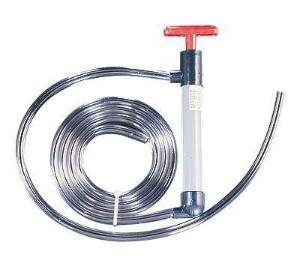The siphon principle Surface tension causes the liquid stream in the flying-droplet siphon to split into distinct droplets inside of an air-filled, enclosed chamber. This keeps the liquids moving up and down from coming into contact with one another, which inhibits the liquid tensile strength from dragging the liquid up. A siphon is a tube that, without the use of a pump, permits liquid to go upward, above the origin reservoir’s surface, and then downward to a lower level. The air pressure in the siphon’s bend decreases as a specific volume of water passes over the bend due to gravity pulling it down on the longer leg.
How Should I Siphon Water the Best?
Keeping that end of the hose lower than the other, rapidly disconnect one end with your thumb and take it out of the water. Insert the hose’s open end into the container or location where you want the water to go. The water should start to siphon out as soon as you release your thumb from the closed end of the hose.
A Water Delivery Siphon
Siphons are closed conduits or inverted u-shaped pipes that are primed or filled to allow atmospheric pressure to push water out of one end of the pipe and over an embankment dam from a reservoir. The conduit or pipe is intended to operate at full capacity and with a pressure differential.
Advantages of a Siphon
Siphon tubes’ primary advantage is their low cost and ease of installation—unlike, say, a sluice gate set into the canal’s bank, which requires engineering expertise. As soon as the necessary water level is reached, they can be effortlessly moved from one bay or field to another.
Siphon Method
The siphon hose principle Surface tension causes the liquid stream in the flying-droplet siphon to split into distinct droplets inside of an air-filled, enclosed chamber. This keeps the liquids moving up and down from coming into contact with one another, which inhibits the liquid tensile strength from dragging the liquid up.
Rain Gauge Siphon
A rain gauge that can record rainfall over an extended period is a siphon rain gauge. The gauge is automatically emptied using a siphon. It is not to be mistaken with a siphon pressure gauge, even though it is frequently referred to as a “siphon gauge”.
Drainage via Siphoning
By 2022, a siphon drainage technique will be used on several expressways. According to recent investigations, there was no sign of obstruction and the groundwater level beneath expressway retaining walls can be lowered. To reduce the risk of leaks in the retaining wall over the long term, this new drainage system is being implemented. Since the 1960s, siphon roof-water drainage systems have been in use. Siphon drainage is also utilized to drain unstable slopes.
Spillway Siphon
Since a siphon spillway in a dam is typically employed to drain elevated water levels, it is not strictly speaking a siphon. But if a siphon spillway lifts the flow above the source reservoir’s surface, as happens occasionally when it’s utilized for irrigation, then it functions just like a real siphon. Siphon spillways are classified as “pipe flow” or “closed-duct flow” while they are in use. The height of the reservoir above the spillway controls the regular spillway flow, but the height differential between the input and outflow controls the siphon flow rate.
Certain designs have an automated mechanism that utilizes the water’s spiral vortex flow to draw out air from above and prime the siphon. The volute siphon is one such design.
Terms and Application
Siphoning can assist in preventing the transfer of either the top (foam and floaties) or bottom (dregs) of a liquid into another container when it needs to be filtered. For this reason, siphoning is helpful during the fermentation of wine and beer because it might prevent undesirable contaminants from entering the new container.
After floods, water can be removed from cellars using homemade siphons consisting of pipes or tubes. A pipe or tube is used to provide a connection between the flooded cellar and a deeper area outdoors. In irrigated fields, siphoning is frequently used to move a predetermined volume of water from a ditch over the ditch wall and into furrows.
Large siphons can be found in industry and municipal waterworks. The siphon’s crest, intake, and outflow valves are used to regulate their size. Closing the input and outputs and filling the siphon at the crest can prime the siphon. To prime the siphon, a vacuum pump may be used at the crest if the intakes and exits are submerged.
Conclusion
The principle of siphoning Within a confined, air-filled chamber, surface tension causes the liquid stream in the flying-droplet siphon to divide into separate droplets. As a result, the liquid tensile strength is prevented from pulling the liquid upward by preventing the moving liquids from coming into touch with one another.
